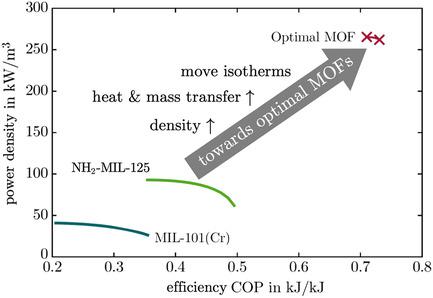当前位置:
X-MOL 学术
›
Energy Technol.
›
论文详情
Our official English website, www.x-mol.net, welcomes your
feedback! (Note: you will need to create a separate account there.)
Toward Optimal Metal–Organic Frameworks for Adsorption Chillers: Insights from the Scale‐Up of MIL‐101(Cr) and NH2‐MIL‐125
Energy Technology ( IF 3.6 ) Pub Date : 2019-10-16 , DOI: 10.1002/ente.201900617 Stefan Graf 1 , Florian Redder 1 , Uwe Bau 1 , Martijn de Lange 2 , Freek Kapteijn 2 , André Bardow 1, 3
Energy Technology ( IF 3.6 ) Pub Date : 2019-10-16 , DOI: 10.1002/ente.201900617 Stefan Graf 1 , Florian Redder 1 , Uwe Bau 1 , Martijn de Lange 2 , Freek Kapteijn 2 , André Bardow 1, 3
Affiliation

|
The metal–organic frameworks (MOFs) MIL‐101(Cr) and NH2‐MIL‐125 offer high adsorption capacities and have therefore been suggested for sustainable energy conversion in adsorption chillers. Herein, these MOFs are benchmarked to commercial Siogel. The evaluation method combines small‐scale experiments with dynamic modeling of full‐scale adsorption chillers. For the common temperature set 10/30/80 °C, it is found that MIL‐101(Cr) has the highest adsorption capacity, but considerably lower efficiency (−19%) and power density (−66%) than Siogel. NH2‐MIL‐125 increases efficiency by 18% compared with Siogel, but reduces the practically important power density by 28%. From the results, guidelines for MOF development are derived: High efficiencies are achieved by matching the shape of the isotherms to the specific operating temperatures. By only adapting shape, efficiencies are 1.5 times higher. Also, higher power density requires matching the shape of the isotherms to create high driving forces for heat and mass transfer. Second, if MOFs’ heat and mass transfer coefficients could reach the level of Siogel, their maximum power density would double. Thus, development of MOFs should go beyond adsorption capacity, and tune the structure to the application requirements. As a result, MOFs could to serve as optimal adsorbents for sustainable energy conversion.
中文翻译:

迈向吸附式制冷机的最佳金属有机框架:MIL-101(Cr)和NH2-MIL-125规模放大的见解
金属有机框架(MOF)MIL-101(Cr)和NH 2 -MIL-125具有很高的吸附能力,因此建议在吸附式冷却器中进行可持续的能量转换。在此,这些MOF以商业Siogel为基准。该评估方法将小规模实验与全尺寸吸附式制冷机的动态建模结合在一起。对于普通温度设置10/30/80°C,发现MIL-101(Cr)具有最高的吸附容量,但效率(−19%)和功率密度(−66%)比Siogel低。NH 2‐MIL‐125与Siogel相比,效率提高了18%,但实际上却降低了28%的重要功率密度。从结果中得出了MOF开发的指导原则:通过将等温线的形状与特定的工作温度匹配,可以实现高效率。仅通过调整形状,效率就提高了1.5倍。同样,更高的功率密度需要匹配等温线的形状,以产生用于热量和质量传递的高驱动力。其次,如果MOF的传热和传质系数可以达到Siogel的水平,则它们的最大功率密度将增加一倍。因此,MOF的开发应超出吸附能力,并根据应用要求调整结构。结果,MOF可以作为可持续能源转换的最佳吸附剂。
更新日期:2019-10-16
中文翻译:

迈向吸附式制冷机的最佳金属有机框架:MIL-101(Cr)和NH2-MIL-125规模放大的见解
金属有机框架(MOF)MIL-101(Cr)和NH 2 -MIL-125具有很高的吸附能力,因此建议在吸附式冷却器中进行可持续的能量转换。在此,这些MOF以商业Siogel为基准。该评估方法将小规模实验与全尺寸吸附式制冷机的动态建模结合在一起。对于普通温度设置10/30/80°C,发现MIL-101(Cr)具有最高的吸附容量,但效率(−19%)和功率密度(−66%)比Siogel低。NH 2‐MIL‐125与Siogel相比,效率提高了18%,但实际上却降低了28%的重要功率密度。从结果中得出了MOF开发的指导原则:通过将等温线的形状与特定的工作温度匹配,可以实现高效率。仅通过调整形状,效率就提高了1.5倍。同样,更高的功率密度需要匹配等温线的形状,以产生用于热量和质量传递的高驱动力。其次,如果MOF的传热和传质系数可以达到Siogel的水平,则它们的最大功率密度将增加一倍。因此,MOF的开发应超出吸附能力,并根据应用要求调整结构。结果,MOF可以作为可持续能源转换的最佳吸附剂。











































 京公网安备 11010802027423号
京公网安备 11010802027423号